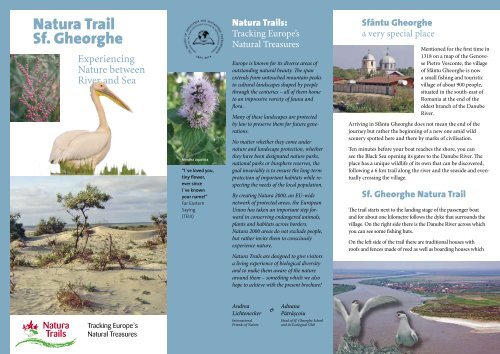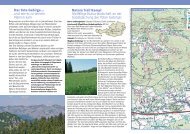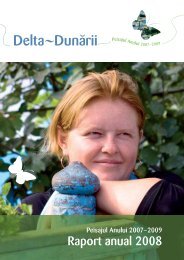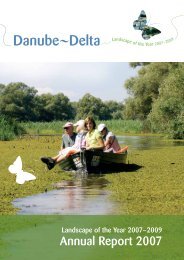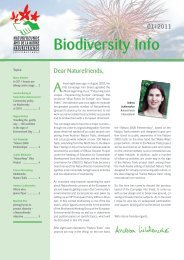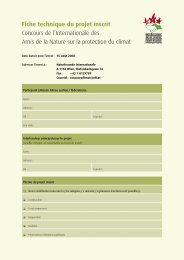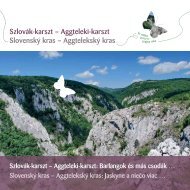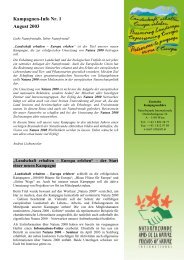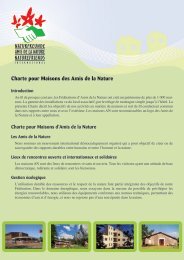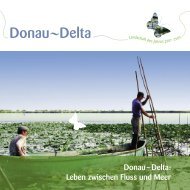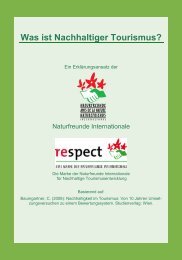Natura Trail Sf. Gheorghe
Natura Trail Sf. Gheorghe
Natura Trail Sf. Gheorghe
- No tags were found...
You also want an ePaper? Increase the reach of your titles
YUMPU automatically turns print PDFs into web optimized ePapers that Google loves.
<strong>Natura</strong> <strong>Trail</strong><strong>Sf</strong>. <strong>Gheorghe</strong>ExperiencingNature betweenRiver and SeaMentha aquatica“I´ve loved you,tiny flower,ever sinceI´ve knownyour name!”Far EasternSaying(TEIJI)<strong>Natura</strong> <strong>Trail</strong>s:Tracking Europe’s<strong>Natura</strong>l TreasuresEurope is known for its diverse areas ofoutstanding natural beauty. The spanextends from untouched mountain peaksto cultural landscapes shaped by peoplethrough the centuries – all of them hometo an impressive variety of fauna andflora.Many of these landscapes are protectedby law to preserve them for future generations.No matter whether they come undernature and landscape protection, whetherthey have been designated nature parks,national parks or biosphere reserves, thegoal invariably is to ensure the long-termprotection of important habitats while respectingthe needs of the local population.By creating <strong>Natura</strong> 2000, an EU-widenetwork of protected areas, the EuropeanUnion has taken an important step forwardin conserving endangered animals,plants and habitats across borders.<strong>Natura</strong> 2000 areas do not exclude people,but rather invite them to consciouslyexperience nature.<strong>Natura</strong> <strong>Trail</strong>s are designed to give visitorsa living experience of biological diversityand to make them aware of the naturearound them – something which we alsohope to achieve with the present brochure!<strong>Sf</strong>ântu <strong>Gheorghe</strong>a very special placeMentioned for the first time in1318 on a map of the GenovesePietro Vesconte, the villageof <strong>Sf</strong>ântu <strong>Gheorghe</strong> is nowa small fishing and touristicvillage of about 900 people,situated in the south-east ofRomania at the end of theoldest branch of the DanubeRiver.Arriving in <strong>Sf</strong>ântu <strong>Gheorghe</strong> does not mean the end of thejourney but rather the beginning of a new one amid wildscenery spotted here and there by marks of civilisation.Ten minutes before your boat reaches the shore, you cansee the Black Sea opening its gates to the Danube River. Theplace has a unique wildlife of its own that can be discovered,following a 6 km trail along the river and the seaside and eventuallycrossing the village.<strong>Sf</strong>. <strong>Gheorghe</strong> <strong>Natura</strong> <strong>Trail</strong>The trail starts next to the landing stage of the passenger boatand for about one kilometre follows the dyke that surrounds thevillage. On the right side there is the Danube River across whichyou can see some fishing huts.On the left side of the trail there are traditional houses withroofs and fences made of reed as well as boarding houses whichTracking Europe’s<strong>Natura</strong>l TreasuresAndreaLichteneckerInternationalFriends of Nature&AdnanaPătrăşcoiuHead of <strong>Sf</strong>. <strong>Gheorghe</strong> Schooland its Ecological Club
offer tourists accommodation and traditional food . The villageis closed off by an expanding, exclusive tourism complex and amilitary base.Along its entire length, this part of the trail is bordered by bushes,such as Saltcedar (Tamarix ramosissima) and diverse willows(Salix sp.), by herbs, such as Common horehound (Marrubiumvulgare) and Water mint (Mentha aquatica), and close to or in thewater, Reed (Phragmites communis), Reed-mace (Typha angustifolia)and Bur reed (Sparganium erectum), Yellow water iris (Irispseudacorus) as well as White and Yellow water lilies (Nymphaeaalba; Nuphar lutea).Useful & beautiful:Plants at and on the waterAll the plants which grow at the borders of or in the water havedeveloped characteristics that enable them to survive in thisspecial environment, which is marked by changing water levels.Reed (Phragmites communis)The Danube Delta holds the largest compact area of reedworldwide (approx. 1800 km²). It serves as a refuge for waterfowlsand fish and at the same time as a natural filter thatabsorbs nutrients and heavy metals entrained by the watersof the Danube. Thus, if the pelican is the symbol of the Delta’sfauna, the reed is its emblematic plant.Its name is derived from the Greek “phragma”,which signifies “braid”. It is up to 4meters high, with a hollow, jointed stem.The adventitious roots are pushed by nodesat the basis of the stem, while the leavesare pushed by the nodes on the upper part. The flowers, calledpanicles, resemble an inflorescence with a main axis whoseramifications are getting shorter towards the top. Vigorousunderground rhizomes cause the plant to spread quickly.Since time immemorial, people in the delta have used reed forroofing, mats and fences, but also as fuel and forage. Its physicalproperties – it is heat-insulating and sound-absorbing,solid and yet light – make reed also an excellent raw materialfor the production of ecological construction material.The White water lily(Nymphaea alba)The White water lily is a perennialplant which is found in lakes andswamps, everywhere in the DanubeDelta. As the roots are fixed in theground, the length of the stem dependson the depth of the water. The leaves are large (10–30 cmdiameter) and oval. They have a water-repellent surface andstomata on the upper side which enable the plant to breathe.The flower is white, with four sepals and 20–25 petals each.The fruit is oval and the seeds are sweet and edible. It blossomsfrom June to September. Nowadays it is an endangered speciesand protected by law.There is also a Yellow water lily (Nuphar lutea) whose flower issmaller.Once you leave the village, the trail takes you through wilderscenery: on the right, there is a small channel, which insummer is covered with White and Yellow water lilies, and amarsh. On the opposite side, old German bunkers from theSecond World War testify to the tumultuous history of thispart of the country. Examples of the totally different flora andfauna, typical of salted soils, are the Saltwort (Salsola soda, seetitle page), the Common glasswort (Salicornia europaea) and theBuckhorn plantain (Plantago coronopus).The trail leads first to the main path and then turns right, ontoa path that leads to the bank of the Danube. Here you can hearthe songs and calls of many small birds or, if you are lucky,watch lizards, turtles and snakes basking in the sun. Afterabout one kilometre, the path opens to a magnificent view ofthe river as it flows into the sea, while the sand becomes finerand is covered with plants typical of the sea shore.(Caution: Though it might be tempting, do not swim in theDanube at this place – there are dangerous vorteces!)Traces in the sandYou will rarely see a snake or turtle. Most likely you will onlyfind their traces in the sand.Steppe Viper(Vipera ursinii renardi)Although it is only a sporadic species inthis area, you might see a venomous snake– the Steppe viper – on the trail. Youcan easily recognize it by the V drawingon the head. Good to know: The steppeviper bite is not deadly, but if it happens,please go immediately to the sanitarypoint in the centre of the village.European pond terrapin (Emys orbicularis)This turtle is found throughout Europe, in Western Asia andNorth-West Africa. In Romania, it used to be spread almost allover the country, but currently its numbers are dwindling alarmingly,due to habitat loss, pollution, hydrological constructionsand human interference. In all the countries, where it isfound, it is strictly protected by national and EU law (HabitatDirective).Its favourite haunts are lake banks with rich water flora andmarshes, where it enjoys basking in the sun. It is a very agileand ferocious species, feeding on shell fish, terrestrial invertebrates,rodents, even young birds, fish, insects, worms andvery rarely on some plants. The bodies of adult turtles reach15–25 cm in length. Their shell is dark brown to black withsmall yellow spots or lines. The same pattern is repeated ontheir heads, necks and legs.
From the end of autumn to April the turtle hibernates at thebottom of lakes and rivers. Between May and June, the femalelays 3–16 eggs on the frequently flooded shores.Walking along the river, you can admire Sahalin Island on theright, which is about 15 km long. By dint of its location at themouth of the river it represents a very special biotope, which iscalled “meleaua” (from the Russian “malii” or “melkii” for small– in the given case referring to the shallowness of the water).Where the salt water of the sea mingles with the fresh water ofthe delta, thousands of birds find a perfect habitat where theystop during their long migratory flights to rest or to breed.Short-term guests –migratory birds in the deltaThe PelicanThe pelican is the symbol of the Danube Delta, and you arevery likely to see a flock of pelicans when walking on this trail:One of their favourite haunts is close to the river’s mouth onthe opposite bank.Two species of pelicans can be found in the delta: The Whitepelican (Pelecanus onocrotalus), which lives in colonies, and theespecially rare Dalmatian pelican (Pelecanus crispus). The twospecies can be identified by the colour of their wings (darkflight feathers for the White pelican and greyish-white onesfor the Dalmatian pelican), by the colour of their bill pouches(bright yellow-orange for the White pelican and yellowfor the Dalmatian pelican) and by the colour of their eyes(yellowish-white for the Dalmatian pelican and red for theWhite pelican).These big water birds feed on fish and nest in colonies in wetlands– most of the European population in the Danube Delta.Despite their weight, they fly easily at high altitudes withslow wing beatings followed by soaring. This can be watchedespecially in the early autumn when the pelicans prepare tomigrate to the north-eastern coast of Africa where they spendthe winter.Centuries ago, nature was less polluted and there were millionsof pelicans. Nowadays, the pelican is an endangered species.The Common tern(Sterna hirundo)Also known as sea swallow.Its plumage is white and grey,the head black; the legs are redand the thin bill is red witha black tip. The tern plungedivesfor fish – an impressingperformance accompanied bythe characteristic shrill piping– something which can be frequently watched when walkingalong the Danube. The Common tern breeds in colonies, thelargest of which is found on Sahalin island in the DanubeDelta.The European roller (Coracias garrulus)The only member of the roller family to breed in Europe. It is apretty rare bird which prefers open country with tall trees fullof hollows. Its wings and body are bright blue and the lowerparts of the wings are blue-violet – which makes it a strikingbird in its flight, with the brilliant blue contrasting with blackflight feathers. Its back is light brown. In the Danube Delta itcan be frequently seen on overhead wires or in tall trees.Following the shore for another ten to fifteen minutes, youwill observe millions of different shells shimmering in the sunand you will come upon the finest sand of the entire Black Seaseaside.Farther out on the dunes a very delicateplant – the Sand morningglory (Convolvulus persicus)– opens its whiteflowers between SiberianSea rosemary (Argusiasibirica) and Sea holly(Eryngium maritimum).Sand morning glory(Convolvulus persicus)The name of the plant genusis derived from the Latinconvolvere (to twine), a termthat refers to the plant’s climbingstem. It has a very longunderground rhizome. Thestem is about 50 cm high,velvety and greenish-white.The leaves are thick and big,velvety and covered withfine hair. The flowers are big,white and cup shaped.“Just admire it and thinkit belongs to this place,not to a glass of water!”(Dănuţ)The plant grows only in a few places in the country, on sandyhabitats, such as the dunes along the Black Sea, especially onthe seashore between <strong>Sf</strong>. <strong>Gheorghe</strong> and Sulina. Because of itsbeauty and of the dramatic population decrease, the plant isnow protected by law.After a walk of about four kilometres,a swim and a rest maybe indicated before returningto the village on a broad sandypath that takes you throughopen country with Mattedsealavender (Limonium bellidifolium),shrubs of Salt cedar(Tamarix ramosissima), Seaberry or Sea buckthorn (Hippophaerhamnoides) and Russianolive or oleaster (Elaeagnusangustifolia).The trail follows the way tothe camping area, where youcan have a cold drink andsomething to eat. The walkthrough the village takes you back to civilization and offersyou the chance to get in touch with local life.Even at 120 km from the nearest town, <strong>Sf</strong>. <strong>Gheorghe</strong> is not theisolated community it might seem to be. Distance and difficultaccess, which is possible only by water, have preserved it as aunique place where people and nature have lived in harmonyfor centuries.
Protected AreasYour contacts in the region:Prietenii Naturii TulceaSilviu Covaliov / Danube Delta National Institutefor Research & Development Tulcea820112, Tulcea, Babadag str. 165, RomâniaTel.: +40 240 524550 / Mob.: +40 751179189Email: prieteniinaturii.tulcea@gmail.comDanube Delta Biosphere Reserve Administration (DDBRA)820243 Tulcea, Portului str. 34A, RomâniaTel.: +40 240 51 89 45Email: arbdd@ddbra.ro; www.ddbra.ro<strong>Sf</strong>. <strong>Gheorghe</strong> School / Ecological ClubAdnana Pătrăşcoiu827195, <strong>Sf</strong>. <strong>Gheorghe</strong> / Tulcea, RomâniaEmail: scoala_sf.gheorghe@yahoo.comNaturefriends International (NFI)Diefenbachgasse 36, A-1150 Viennanfi@nfi.at, www.nfi.atPublished by: Naturefriends International (NFI), 1150 Vienna, Diefenbachgasse 36, Austria. A projectimplemented in the framework of “Danube Delta – Landscape of the Year 2007–2009”, in cooperationwith Naturefriends Romania, the Danube Delta National Institute (DDNI), the Danube Delta BiosphereReserve Administration (ARBDD) and <strong>Sf</strong>. <strong>Gheorghe</strong> School’s Ecological Club. Grant-aided by the EuropeanUnion. Text: Silviu Covaliov, Adnana Pătrăşcoiu, Stefanie Röder. Photo graphs: Dan Bandacu,Silviu Covaliov, Mihai Doroftei, Stefanie Röder, Tiberiu Tioc. Printing: Printed in compliance with theAustrian Eco-Quality Label – Directive on “low-polluting printing products.” gugler cross media, Melk;UWZ 609; www.gugler.at // December 2008This <strong>Natura</strong> <strong>Trail</strong> was developed together with the pupils andmembers of the <strong>Sf</strong>. <strong>Gheorghe</strong> School’s Ecological Club: DănuţACSENTE, Iulian Cristian AVRAMOV, Albert Alexandru BON-DARENCU, Ioan Gabriel CERNAMORIŢ, Dimitrias AlexandruCONSTANTIN, Dumitrel Costin DIMACHE, Victor DIMACHE,Cristian HALCHIN, Silviu HALCHIN, Mirel LUCA, Ciprian NicolaeMASTICĂ, Diana Paraschiva MOLDOVEANU, MarianMădălin MUNTEANU, Ionela Aurora PAIMSCHI, Ionuţ SABLO-SCHI, Mădălina Ioana SABLOSCHI, Adrian Constantin SIDO-RENCU, Andrei SIDORENCU, Nicu TURTOI, Alexandru ŞtefănuţVOICU. Special thanks to Mihai Doroftei, biologist at the DDNI.Biosphere Reserves… form part of the worldwide network of UNESCO BiosphereReserves, which comprises large-scale ecosystems of outstandingimportance to the preservation of biodiversity. BiosphereReserves are created to promote and demonstrate a balancedrelationship between humans and the biosphere.This is why nature conservation is combined with the preservationof cultural diversity and the promotion of research andeducation.This calls for appropriate zoning and management. Hence,biosphere reserves include strictly protected areas, a surroundingbuffer zone where the use of resources is limited, anda transition area, where sustainable resource managementpractices are developed in cooperation with and for the benefitof local people and communities.The Danube Delta Biosphere Reserve was established in 1990.<strong>Natura</strong> 2000… is a European programme aimed at theprotection and management of vulnerablespecies and habitats in their naturalterritory, regardless of political boundaries.<strong>Natura</strong> 2000 areas are protected sites, designated in compliancewith two EU Directives (Fauna-Flora-Habitat Directiveand Bird Protection Directive) and forming part of a EU-widenetwork of protected areas.<strong>Natura</strong> 2000 is NOT a system of strictly protected reserves.There are no restrictions as long as the activities in the area donot endanger the habitats and the species for which the sitewas designated. Usually there is no ban on traditional agriculturaland forestry operations. A management plan regulatespossible activities and necessary conservation measures.<strong>Natura</strong> <strong>Trail</strong>sThe <strong>Natura</strong>-<strong>Trail</strong>s project fosters natureexperience and makes biodiversity moretangible, thus contributing in a major way tothe international “Countdown 2010” initiative.In compliance with the UN Convention of Biodiversity,the initiative strives to significantly reduce biodiversity loss by2010. Friends of Nature actively support Countdown 2010.www.countdown2010.net


